People
30 of Our Favorite Portraits of Queen Elizabeth II to Celebrate Her 63-Year Reign
Lucien Freud and George Condo painted the more controversial portraits.
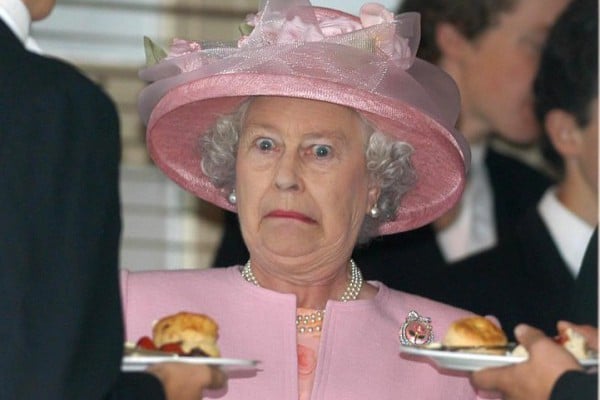
Photo: Mark Stewart.
Lucien Freud and George Condo painted the more controversial portraits.

Sarah Cascone

On September 9, 2015, Queen Elizabeth II surpassed her great-great-grandmother, Queen Victoria, as the longest-reigning monarch in British history. Queen Victoria ruled for 63 years and 216 days.
Marking the occasion is “Long to Reign over Us,” a photography exhibition at the Royal Collection featuring posed portraits and casual family shots of the Queen captured during her tenure.
Over the decades, Queen Elizabeth, age 89, has been the subject of countless paintings and pictures. After a lifetime of official royal photo-ops, the Queen is such a pro in front of the camera, she can even pull off a photo-bomb to make any Millennial proud.
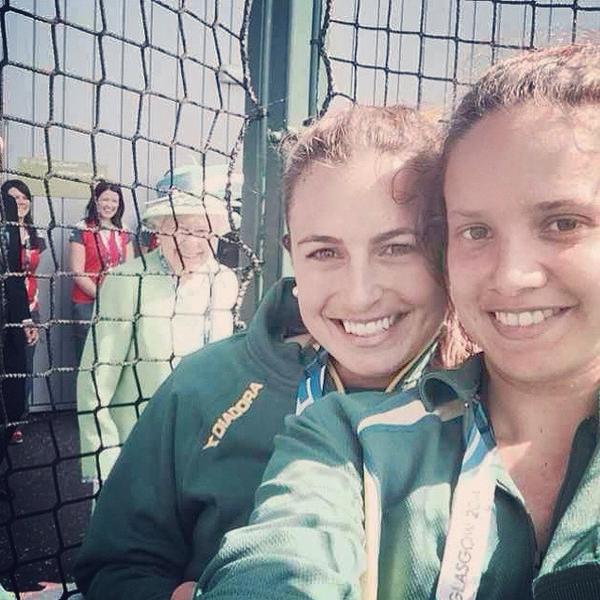
The Queen photobombs a selfie being taken by members of Australia’s women’s hockey team during the 2014 Commonwealth Games.
Photo: Jayde Taylor, via Twitter.
“The Queen is one of the easiest people to photograph,” royal photographer Mark Stewart told artnet News via e-mail. Stewart has spent over 25 years photographing the Queen and her family in over 60 countries around the world,
Portrait sitting, however, is another story: “One thing all artists will tell you is that the Queen does not sit still,” John Wonnacott, who painted the royal family in 2000, told the Telegraph. “And you really cannot say, ‘Ma’am will you please bloody well sit still.'”
In honor of the Queen’s latest regal milestone, artnet News has rounded up 30 of our favorite photos and paintings of the British ruler, including a selection from the Royal Collection exhibition.
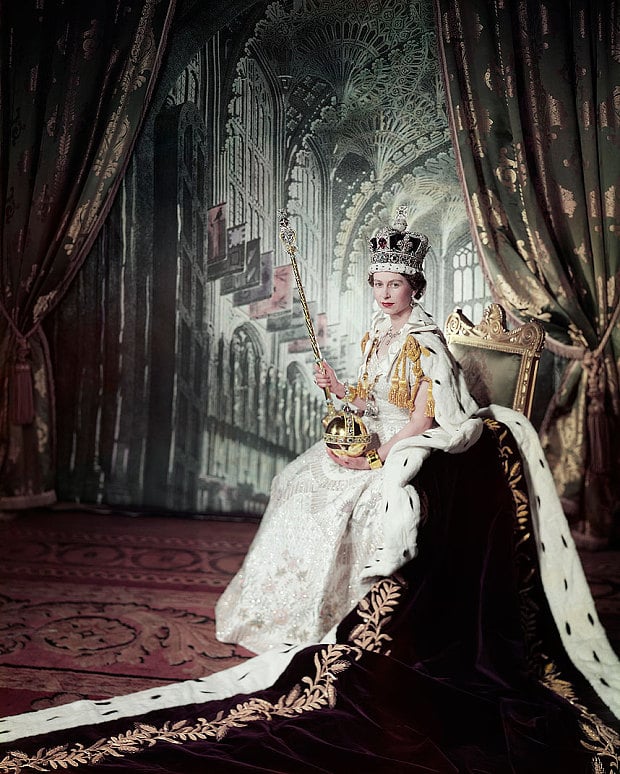
Cecil Beaton, Coronation Day (1953).
Photo: Royal Collection Trust/© Her Majesty Queen Elizabeth II, 2015.
1. Cecil Beaton‘s official coronation portrait of Queen Elizabeth, taken June 2, 1954, is currently on view at the Royal Collection. Although the image appears at first glance to be set in Westminster Abbey, the photographer actually employed a theatrical backdrop for the photo, which was taken in a drawing room at Buckingham Palace. Her Majesty wears the imperial state crown, created for Queen Victoria’s 1838 coronation, and holds the orb and scepter, looking every bit the picture of reigning British royalty.
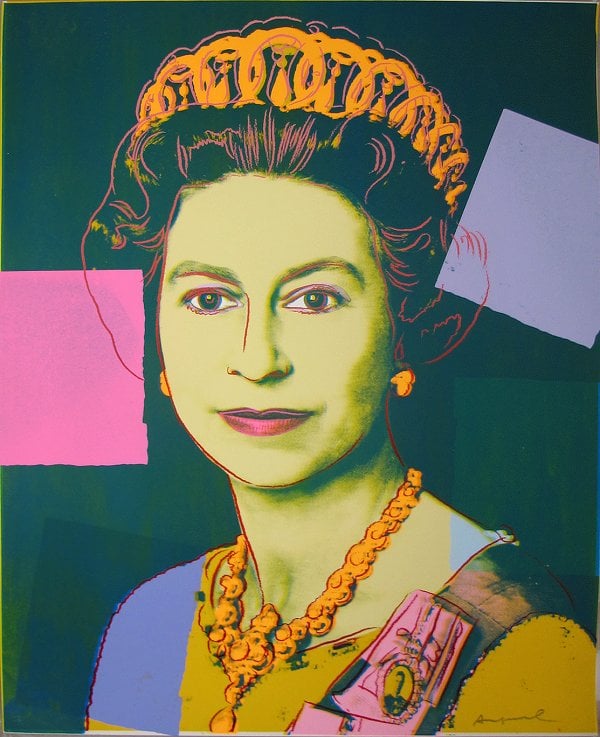
Andy Warhol, Queen Elizabeth (unique) (1985). Courtesy of Adamar Fine Arts.
2. Pop artist Andy Warhol’s last print portrait, of which 16 prints were known to have been made, was based on Queen Elizabeth’s 1977 official Silver Jubilee portrait (when she had ruled for a mere 25 years). Warhol, better-known for his depictions of stars of the silver screen such as Marilyn Monroe and Elizabeth Taylor, silk-screened the British monarch as part of a portrait series of the world’s four reigning queens in 1985 that also included Queen Beatrix of the Netherlands, Queen Margrethe II of Denmark, and Queen Ntombi Twala of Swaziland.
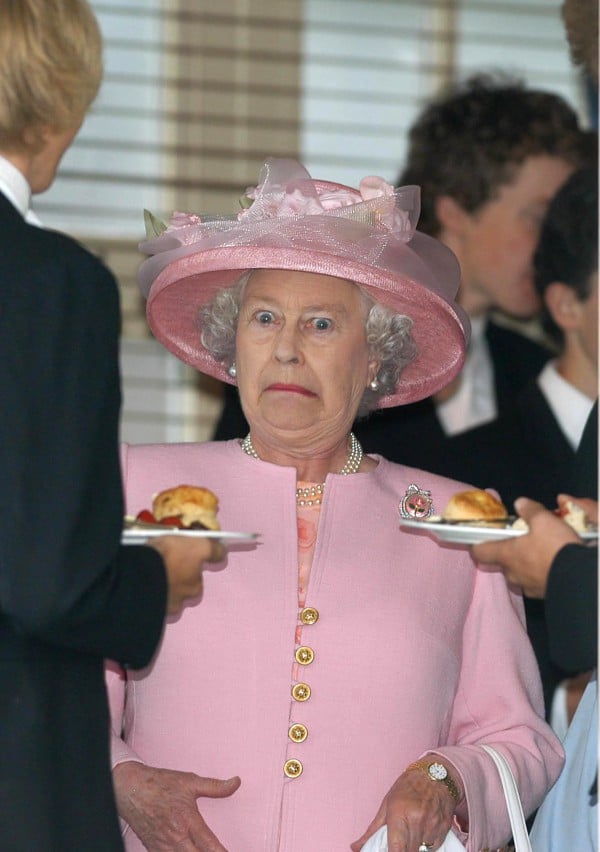
Mark Stewart, The Queen is taken by surprise as she takes tea with Eton schoolboys at Guards Polo Club (2003).
Photo: Mark Stewart.
3. Stewart won a Royal Photographer of the Year award, presented by then-Prime Minister Tony Blair, for this priceless photo of Her Majesty making a disturbed face. “I would love to know what she was saying,” mused Stewart of what he describes a “once-in-a-life-time photograph.” Other highlights from his career with the royal family include being one of only two photographers to capture Queen Elizabeth’s audience with Pope John Paul II in 2000, an experience that “was quite humbling and emotional, and, if I’m honest, caused a butterfly or two!”
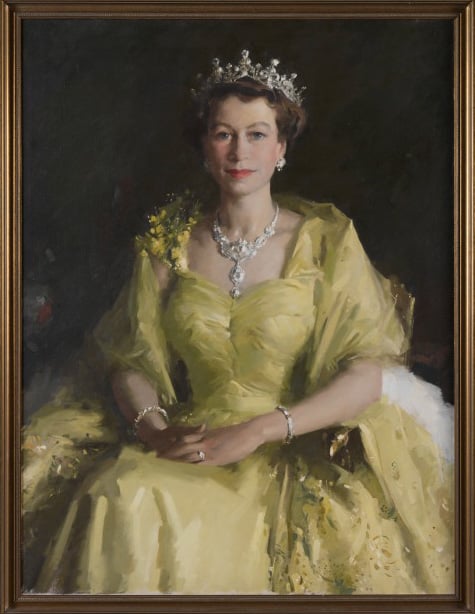
William Dargie, Queen Elizabeth II (1954).
Photo: National Museum Australia.
4. William Dargie painted this image of the Queen in 1954, after she visited Australia in the first trip to the continent by a reigning British monarch. The work, now in the collection of the National Museum Australia, is called the wattle painting because of Her Royal Highness’s golden tulle dress, adorned with golden wattle blossoms, the official floral emblem of Australia.

Dorothy Wilding, The Queen (1952). Photo: Royal Collection Trust, © William Hustler and Georgina Hustler.
5. Dorothy Wilding, the first woman appointed official royal photographer, snapped this black-and-white portrait of the Queen in February 1952, a mere 20 days after she came to the throne. It is the earliest royal portrait included in the Royal Collection Trust exhibition.
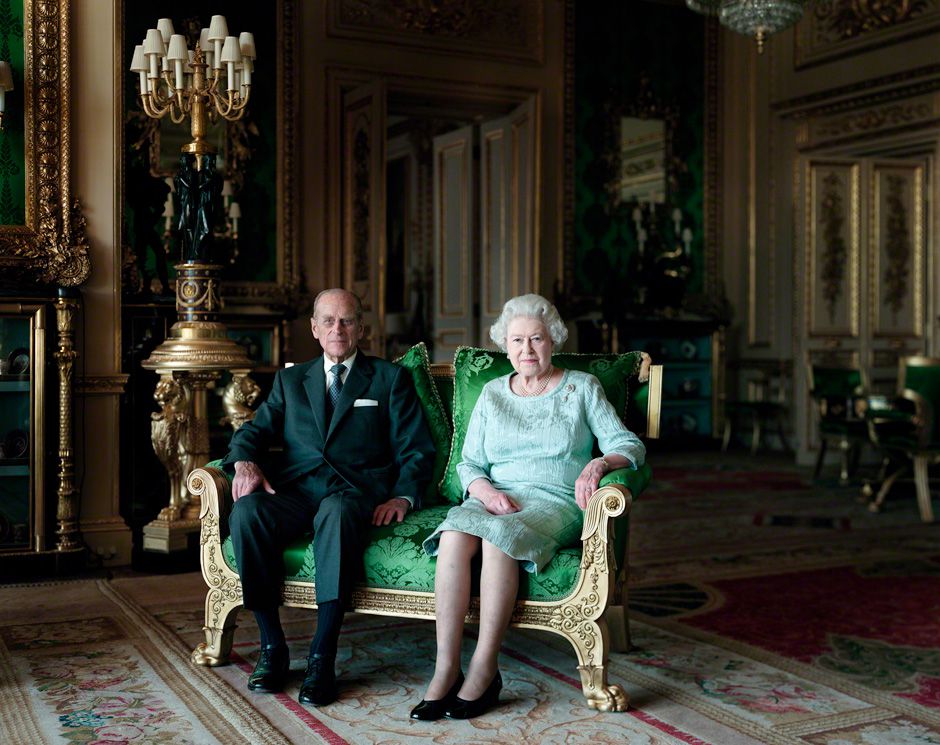
Thomas Struth, Queen Elizabeth II and the Duke of Edinburgh, Windsor Castle (2011).
Photo: Thomas Struth.
6. The Queen commissioned this photo portrait from German photographer Thomas Struth in 2011. The royal couple looks fairly stiff and reserved, perched on an ornate sofa, tilted oddly askew (presumably by Struth) in a richly-gilded high-ceilinged room. (See our artnet Asks interview with Struth.)
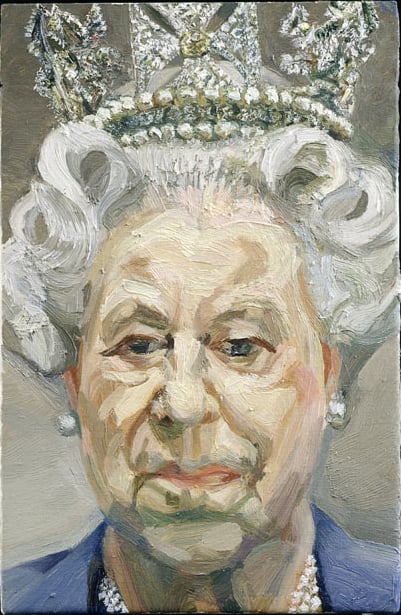
Lucian Freud, HM Queen Elizabeth II
2000–2001 (2001).
Photo: © Royal Collection Trust 2012/the Lucian Freud Archive.
7. This tiny, expressive canvas painted in 2001 by Lucian Freud has managed to dramatically divide opinion. Depicting only the monarch’s head and shoulders, Freud actually had to expand the canvas by 3.5 centimeters when he decided to capture Queen Elizabeth’s diamond diadem as well.

David Dawson, The Queen sits for Lucian Freud (2001) .
Photo: © David Dawson.
Some found the piece unflattering, with Richard Morrison of the London Times noting that “the chin has what can only be described as a six-o’clock shadow.” Others appreciated the naturalism, with the Guardian‘s Adrian Searle calling Freud‘s work “the best royal portrait of any royal anywhere for at least 150 years.”
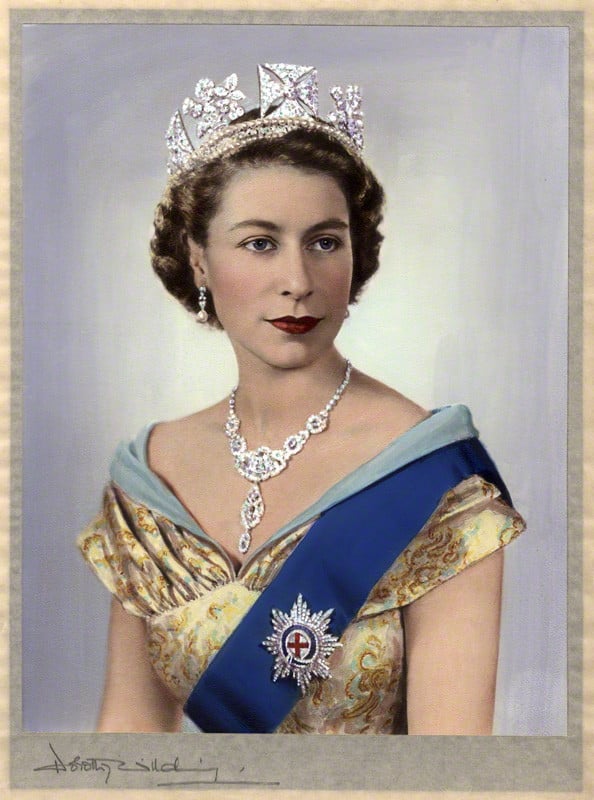
Dorothy Wilding, Queen Elizabeth II, hand-colored by Beatrice Johnson, (1952). Photo: © William Hustler and Georgina Hustler, courtesy the National Portrait Gallery, London.
8. Part of the collection of the National Portrait Gallery in London, this bromide Wilding print was hand-colored by Beatrice Johnson, who worked at the photographer’s studio and frequently collaborated with her on images of the royal family. Another photo from this 1952 portrait session became the first British postage stamp to bear the Queen’s visage.

Nicole Leidenfrost Horse in Royal Blue (2015)
Photo: via the Telegraph
9. This one is not exactly the Queen’s favorite: during a state visit to Germany this year, Her Royal Highness was presented with Nicole Leidenfrost‘s painting of Her Majesty as a young girl on a horse with her father, based on a 1935 picture. Queen Elizabeth was utterly unimpressed, asking German President Joachim Gauck “Have you seen the photo?”

Chris Levine, Lightness of Being, (2012).
Photo: Chris Levine.
10. “I wanted the Queen to feel peaceful,” wrote Levine of the photo in the Guardian, “so I asked her to rest between shots; this was a moment of stillness that just happened.” Levine took this striking image of Queen Elizabeth, full of the gravity of old age and a decades-long reign, in 2004, to mark 800 years of allegiance to the crown by the Island of Jersey. “It has such an aura about it,” he wrote, “a power.”

Dan Llywelyn Hall, Queen Elizabeth II (2013).
Photo: Dan Llewelyn Hall.
11. Created in honor of the 60th anniversary of the Queen’s ascent to the throne (her diamond jubilee), Dan Llywelyn Hall‘s expressionistic rendition of the monarch is not exactly a crowd favorite at Millennium Stadium in Cardiff, Wales. “Never mind hanging the portrait, it is the artist who should be hung,” one local told the Mirror shortly after the work’s unveiling. (Hall is also responsible for a similarly unpopular portrait of an uncharacteristically ruddy-looking Prince William, and was the first official artist-in-residence at Cannes.)
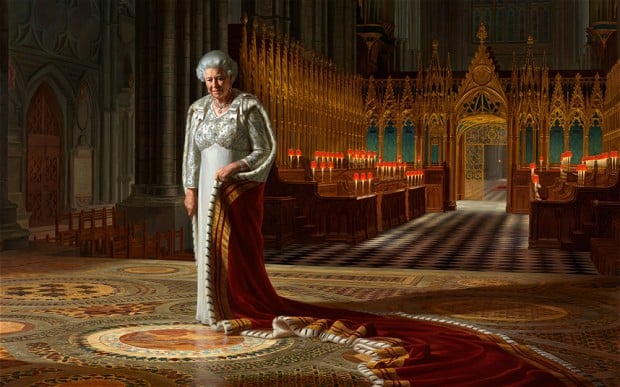
Ralph Heimans, A Portrait of Her Majesty Queen Elizabeth II (2012).
12. Ralph Heimans revisited the Westminster Abbey coronation tableau for his diamond jubilee portrait of the monarch. (The artist actually met with her in the yellow drawing room at Buckingham Palace, the Queen’s preferred setting for portrait sittings.) Heimans spent just one hour with Her Royal Highness in preparation for the piece, describing her to the Telegraph as “the ultimate subject.” Dramatically lit, the canvas highlights the Queen’s more vulnerable side, as she stares down at the spot on the Abbey’s Cosmati pavement where she was crowned in the same cascading robe 60 years earlier.
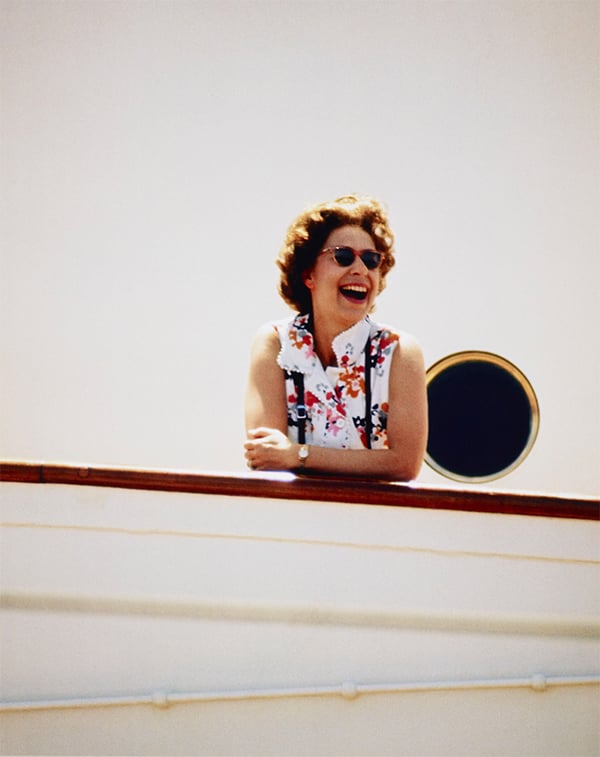
Patrick Lichfield, The Queen on board HMY Britannia (1972). Photo: Patrick Lichfield.
13. This remarkably casual image from Her Majesty’s silver wedding anniversary Far Eastern tour in 1972 shows her in a rare sleeveless dress, head thrown back in laughter at the photographer, Patrick Lichfield, who has been pushed into the pool on board HMY Britannia. “I did have the wit to take a waterproof camera with me and when I came up for about the third time, I took a picture of the Queen up on the bridge laughing at me,” wrote Lichfield of the lighthearted moment, included in the Royal Collection exhibition.
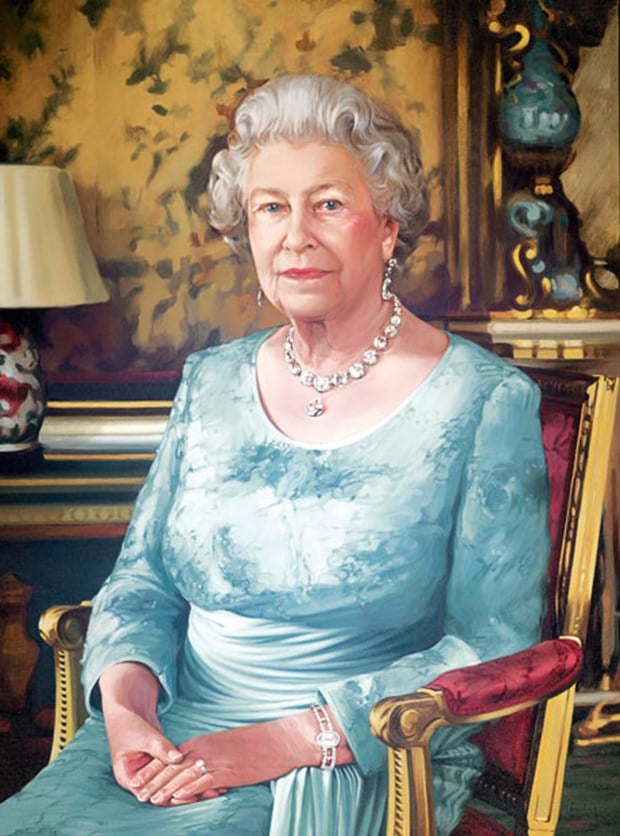
Isobel Peachey, Queen Elizabeth II (2010).
14. Isobel Peachey painted the Queen in 2010 for Cunard’s Queen Elizabeth ocean liner. The monarch posed in the same diamond necklace and earrings that she wore during her coronation. The jewelry originally belonged to Queen Victoria, proving that when it comes to really expensive bling, some things never go out of style.
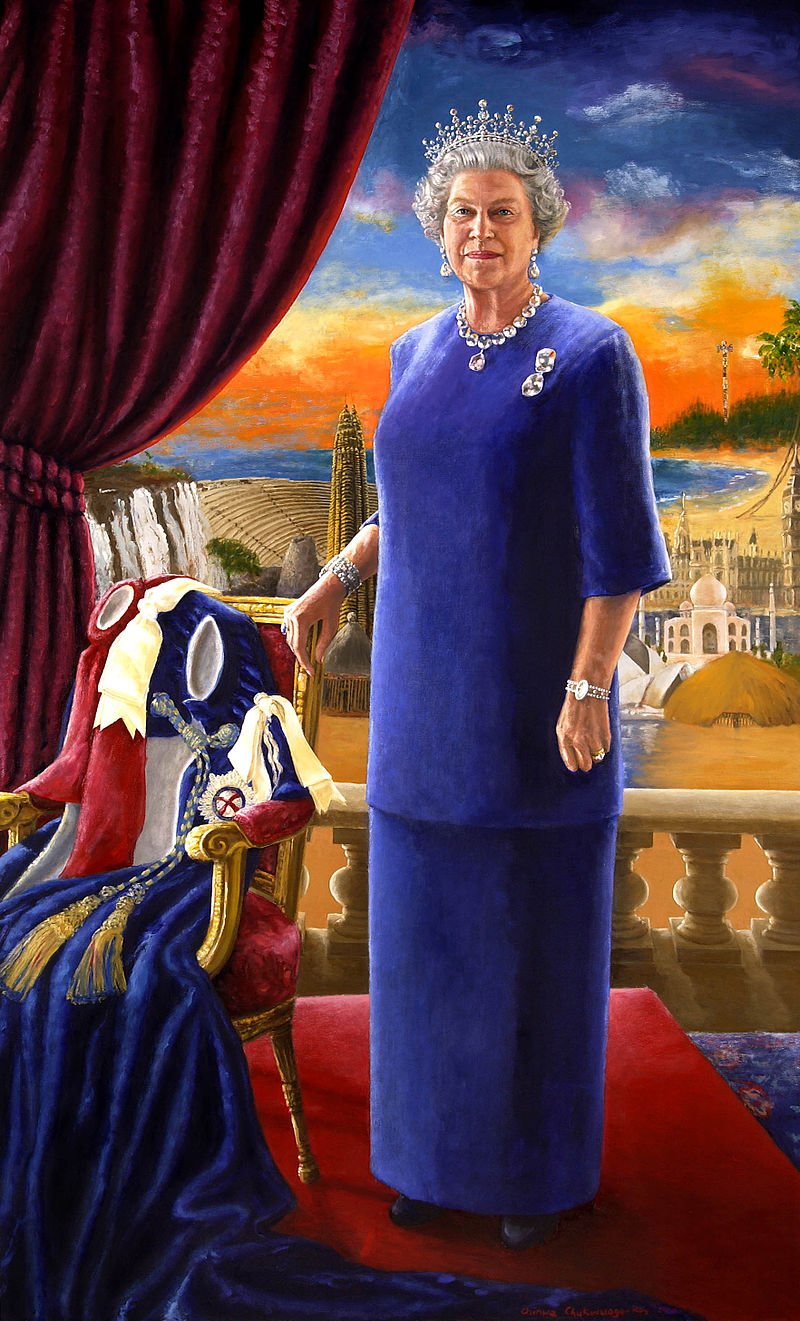
Chinwe Chukwuogo-Roy, HM Queen Elizabeth II (2002).
15. With the Queen’s Golden Jubilee in 2002 came another official portrait of Her Royal Highness, this one commissioned by the Commonwealth Secretariat. The artist, Nigeria’s Chinwe Chukwuogo-Roy, painted Her Majesty in rich jewel tones, standing in front of a vibrant sunset and an imaginative landscape containing iconic places from around the Commonwealth, from India’s Taj Mahal to Montego Bay in Jamaica.
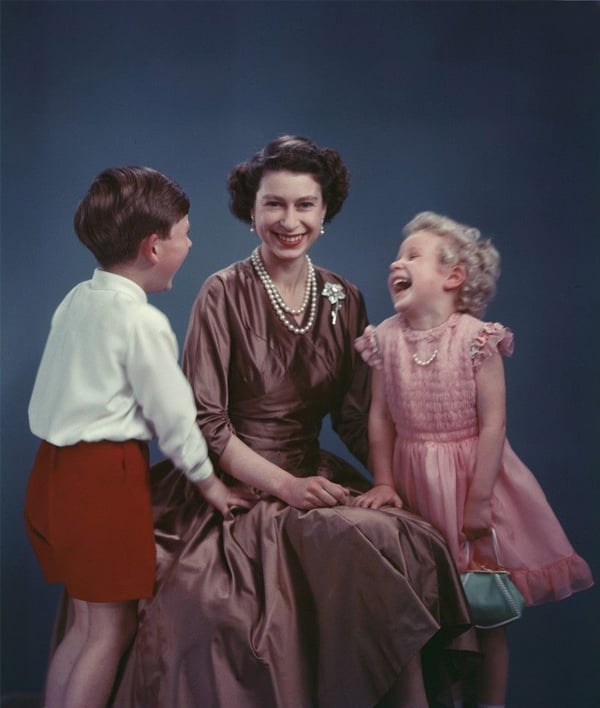
Marcus Adams, The Queen in 1954 with Prince Charles and Princess Anne.
Photo: © Marcus Adams/Camera Press.
16. In 1954, the Queen and her children, Prince Charles and Princess Anne, posed for a portrait with royal photographer Marcus Adams, who also took the monarch’s baby photos back in the 1920s. The resulting image is the picture of a radiant young mother, seated with her adoring children.
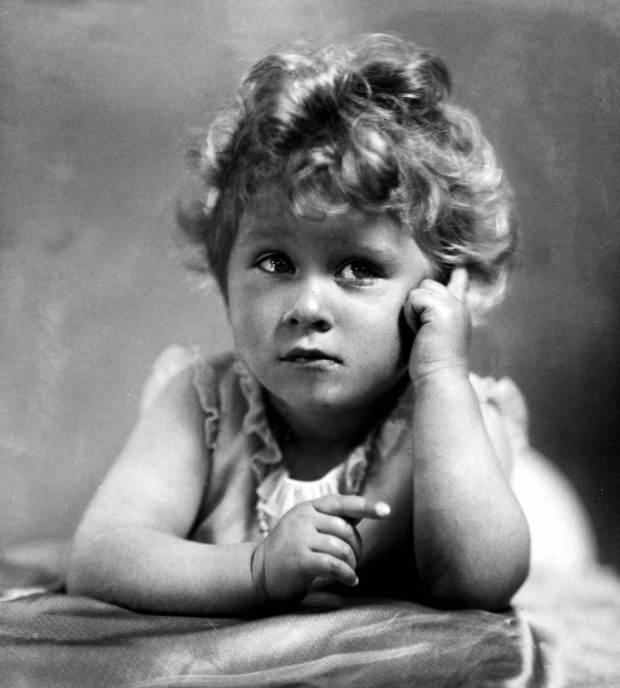
Paul Popper, Princess Elizabeth (1928). Photo: © Marcus Adams/Camera Press.
17. The cherubic little toddler is none other than the Queen herself, back when she was still Princess Elizabeth and just two years old—and more than a little bit bored with getting her picture taken by Adams, known for his images of children.
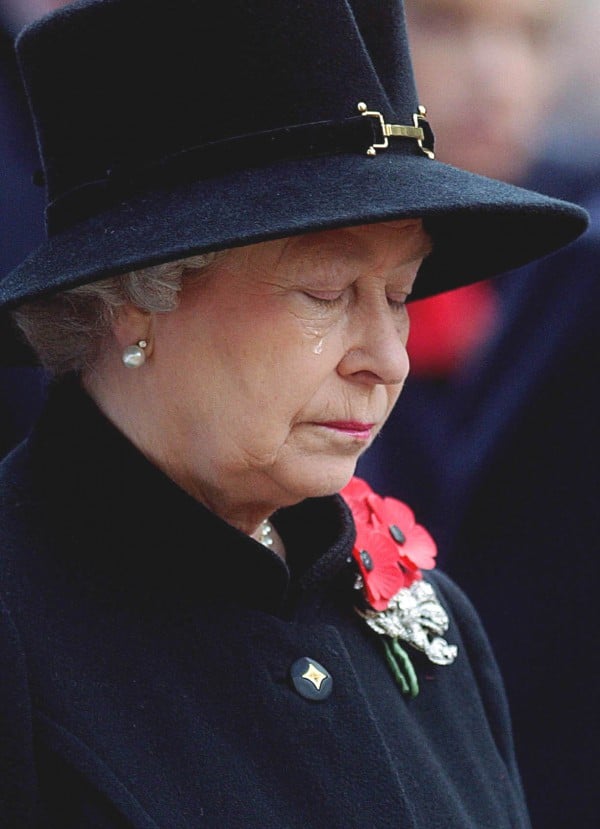
Mark Stewart, The Queen Crying at the Field of Remembrance, Westminster Abbey (2002).
Photo: Mark Stewart.
18. This rare show of emotion from the Queen was captured by Stewart at the opening of Field of Remembrance at Westminster Abbey in 2002. “The ceremony had always been carried out by the Queen Mother, who had died earlier that year, as also had the Queen’s sister Princess Margaret,” explained Stewart. “It was clearly an emotional time for HM, and the first occasion she had stepped into her late mother’s shoes.” The Queen is often portrayed in popular culture as stoic and reserved, particularly in The Queen (2006), starring Helen Mirren and depicting the royal family’s response to the 1997 death of Princess Diana. Her Royal Highness initially chose not to publicly acknowledge the tragedy, much to the distress of the British people.
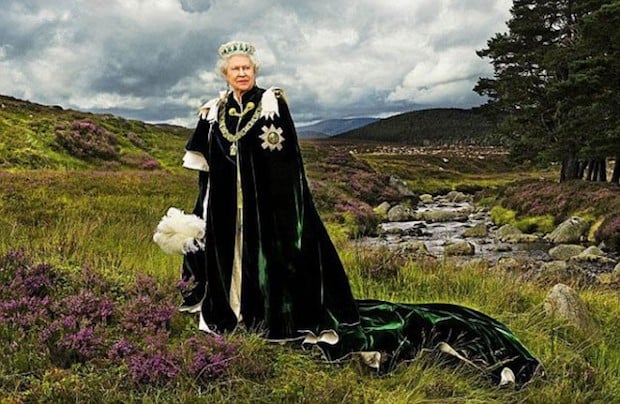
Julian Calder, The Queen of Scots, Sovereign of the Most Ancient and Most Noble Order of the Thistle and Chief of the Chiefs (2010).
Photo: © Julian Calder/Camera Press/Scottish National Portrait Gallery.
19. This dramatic image by Julian Calder is so quintessentially Scottish that the Scottish National Portrait Gallery had to have it for its collection. Shot at the royal family’s estate at Balmoral Castle, the bucolic scene, set amid the heather, looks like something out of fairy tale, and was inspired by the work of Scottish painter Henry Raeburn.
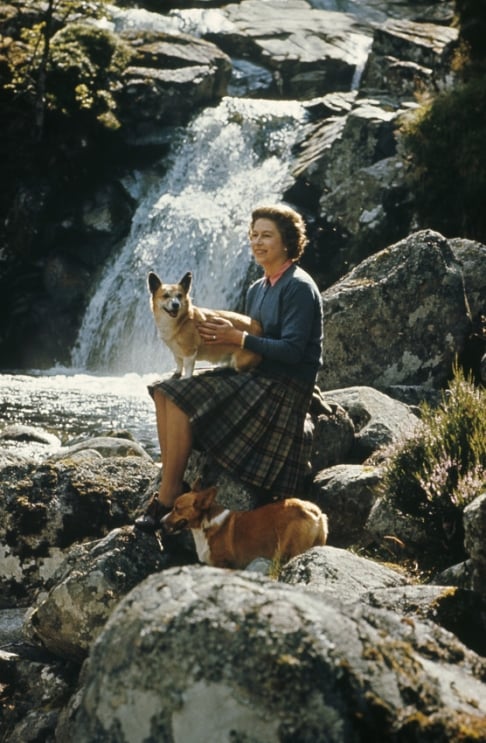
Patrick Lichfield, The Queen at Balmoral, her private residence in Scotland
(1971).
Photo: Patrick Lichfield.
20. Another shot taken at the Balmoral estate, this 1971 photograph by Lichfield is set in front of a roaring waterfall. The Queen, attired in what appears to be a traditional Scottish kilt, poses with two of her beloved corgis—New York magazine reports that she has had over 30 during her lifetime. Both images of Her Majesty at Balmoral are part of the Royal Collection exhibition.
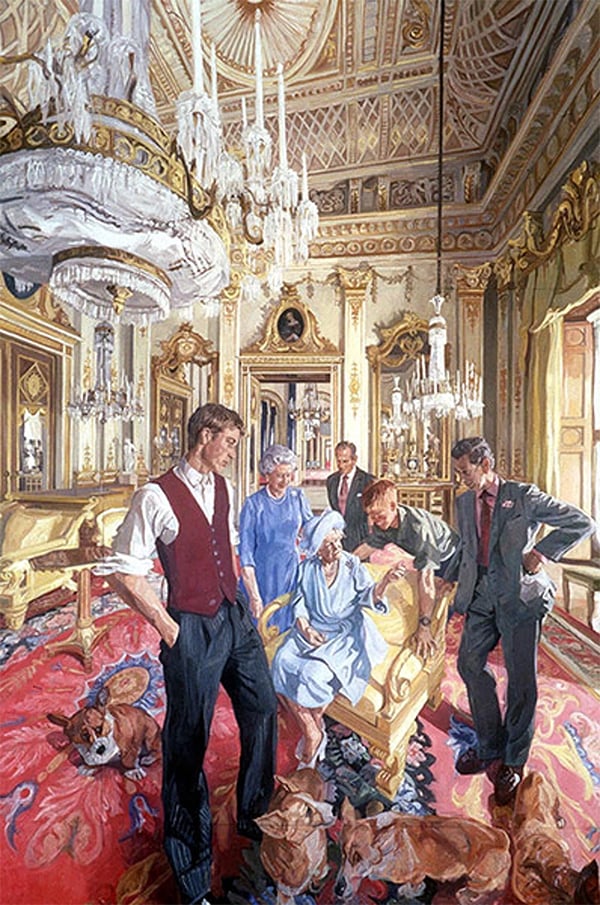
John Wonnacott, The Royal Family: A Centenary Portrait (2000).
Photo: © John Wonnacott/National Portrait Gallery, London.
21. Wonnacott‘s monumental, 12-foot-tall painting saw the royal family and their dogs ushering in a new century. The canvas features an usual composition, with the people clustered in the work’s lower half, chandelier dripping with crystals and an intricately-painted ceiling dominating the rest of the frame. Wonnacott was aware of the pressure put on him by the National Portrait Gallery, telling the Telegraph, “From a purely reputational point of view, if you fail this one, you’ve blown it.” At least one critic felt that he did. “Looking at such portraits, and thinking about the modern royals,” wrote Searlein the Guardian, “is an excoriating business.” (He had yet to have his faith in the genre restored by Freud.)
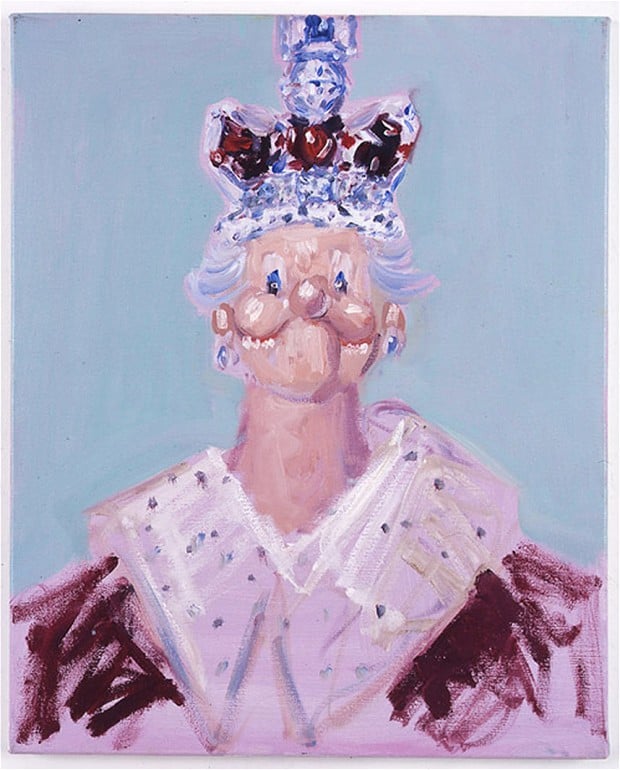
George Condo, Dreams and Nightmares of the Queen (2006). Photo: courtesy the artist, Simon Lee Gallery/Andrea Caratsch/Zurich and Luhring Augustine/Tate Modern.
22. Perhaps the most hated portrait to make our list, this George Condo painting angered Britons for its cartoonish appearance when it was displayed at the Tate Modern in 2006. Derisively nicknamed “The Cabbage Patch Queen” for its resemblance to the popular 1980s children’s toy, the piece was described by the Royal Society of Portrait Painters’ Brendan Kelly to the Evening Standard as “embarrassingly bad.” All things considered, however, the Queen got off easy: Condo originally wanted to paint her naked.
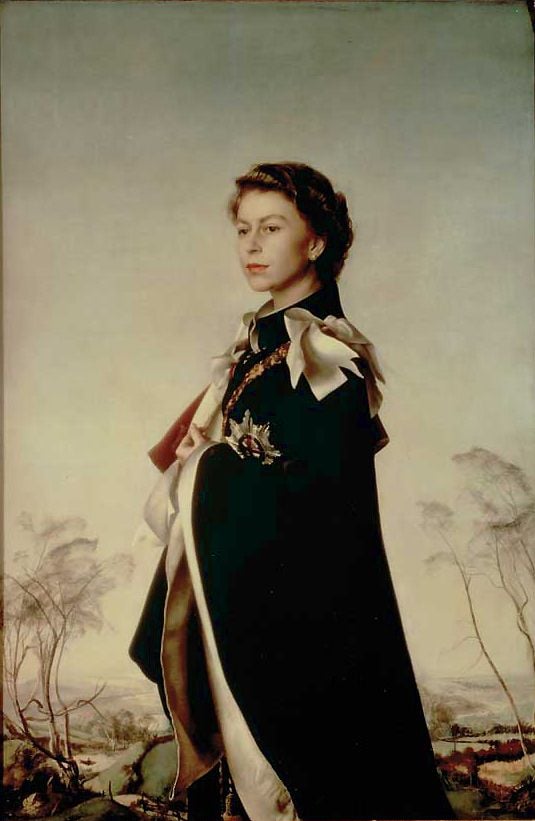
Pietro Annigoni,Queen Elizabeth II, Queen Regent (1954).
Photo: © the Fishmongers’ Company.
23. Pietro Annigoni painted the Queen in 1954, just two years after her coronation. The elegant portrait of the young monarch looks like a promotional image for a period film. Privately owned by London’s Fishmongers’ Company, the painting rarely goes on public view, but has appeared on stamps and currency in British dependencies around the world.

Pietro Annigoni, Queen Elizabeth II, (1969).
Photo: © National Portrait Gallery, London.
24. The Queen never publicly comments on any of her official portraits, but she was apparently so taken with Annigoni‘s work that she asked the National Portrait Gallery to enlist the Italian artist to paint her again in 1969. Where Annigoni’s earlier work was romantic and glamorous, the second painting, seen here in a study, portrayed Her Royal Highness with regal, intimidating authority. “I did not want to paint her as a film star, I saw her as a monarch, alone in the problems of her responsibility,” said the artist of the striking difference. The two were united for just the second time at the National Portrait Gallery in 2012 for “The Queen: Art and Image,” a exhibition for the diamond jubilee.
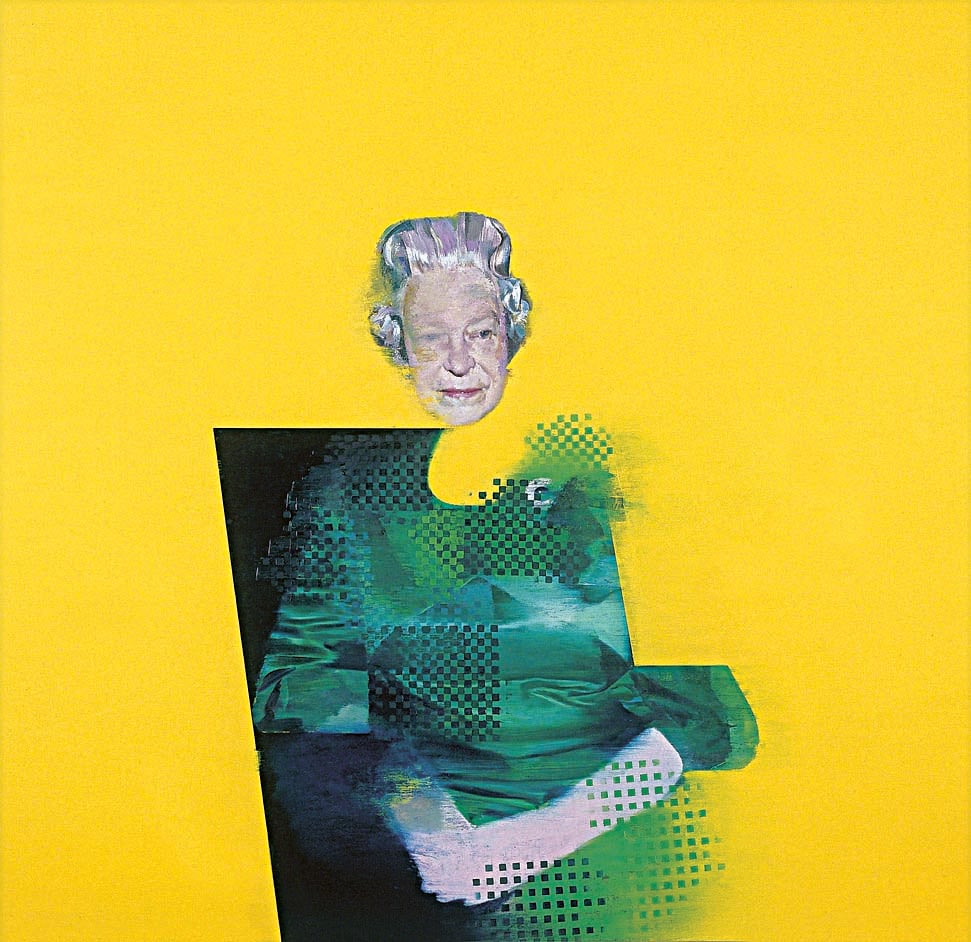
Justin Mortimer, The Queen (1997).
Photo: Justin Mortimer/the RSA.
25. The bright yellow background of Justin Mortimer‘s 1997 portrait of Queen Elizabeth was inspired by Buckingham Palace’s Yellow Drawing Room, where he met with the monarch. Mortimer painted Her Majesty’s head floating above her body to illustrate her detachment and isolation from modern life. “I felt she was from another era,” the artist told the Wall Street Journal. “I don’t have anything in common with her apart from being English.” The unconventional approach was not without its detractors: ” ‘Silly’ Artist Cuts off the Queen’s Head,” read a Daily Mail headline.
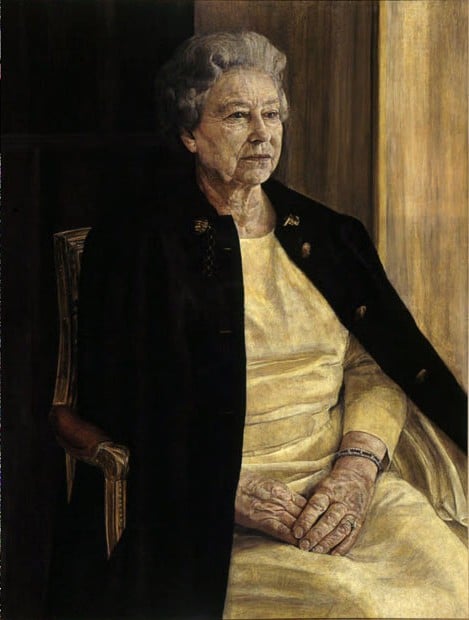
Antony Williams, HM The Queen 1996).
Photo: Antony Williams.
26. This careworn, elderly-looking Queen Elizabeth was painted in 1996 by Antony Williams as part of a commission from the Royal Society of Portrait Painters. When critics complained he had given her “sausage fingers,” Williams told the AP “that’s how they were, I think. That’s what I saw basically.”
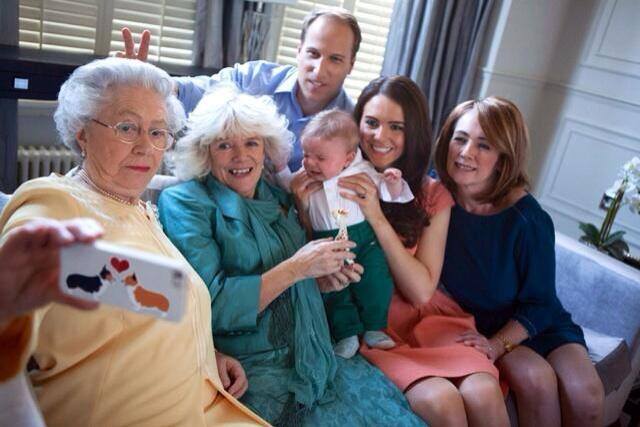
Alison Jackson, The Royal Family learn how to selfie.
Photo: Alison Jackson.
27. No, the Queen isn’t taking her own photos now. This faux royal family selfie is the work of Alison Jackson, a British photographer who crafts convincing personal photos of intimate moments experienced by British celebrities using look alike actors. We’re guessing Her Majesty would not be pleased by Jackson‘s video of her doppelganger on the toilet, but we’re admittedly tickled by the idea of a social media-savvy monarch.
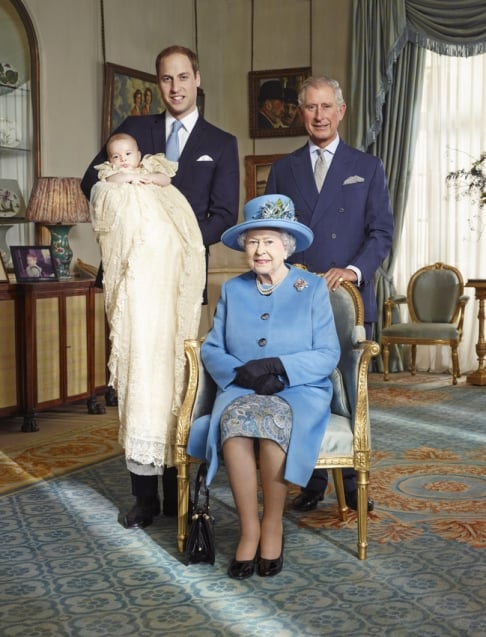
Jason Bell, Four generations of the Royal Family, The Queen with The Prince of Wales, The Duke of Cambridge, and Prince George of Cambridge (2013).
Photo: Jason Bell/Camera Press.
28. The Royal Collection exhibition also looks to the future, with Jason Bell‘s 2013 photo of the Queen with the three next heirs to the throne: Prince Charles, Prince William, and the baby, Prince George.

Queen Elizabeth II.
Photo: Alastair Barford.
29. The Queen’s most recent portrait, commissioned in honor of her surpassing Queen Victoria, was created by Alastair Barford, a 28-year-old janitor. The painting offers an excellent likeness, but Her Majesty’s unusual robes (for the Order of the Garter) look more like those of an esteemed academic at graduation or a Hogwarts professor than that of the head of the Commonwealth.
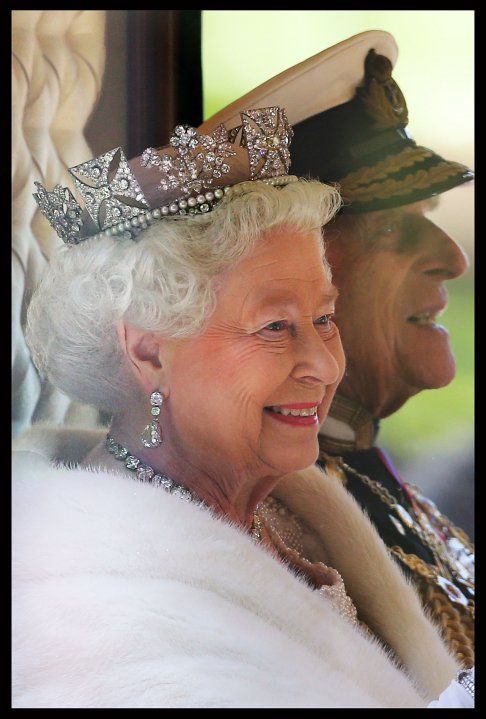
Stephen Lock, The Queen and the Duke of Edinburgh leaving for the State Opening of Parliament (2015). Photo by Stephen Lock.
30. The final image in the Royal Collection show was taken just this May, by Stephen Lock. It shows Her Royal Highness and her husband leaving Buckingham Palace in a carriage, on their way to the state opening of Parliament, where she delivered the Queen’s speech.
“Long to Reign Over Us” is on view at Buckingham Palace, September 9–27, 2015; at Windsor Castle, October 6, 2015–January 5, 2016; and at Palace of Holyroodhouse, January 6–27, 2016.